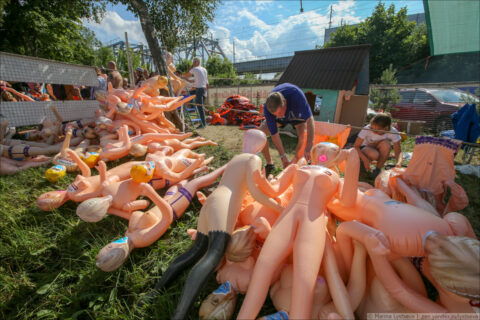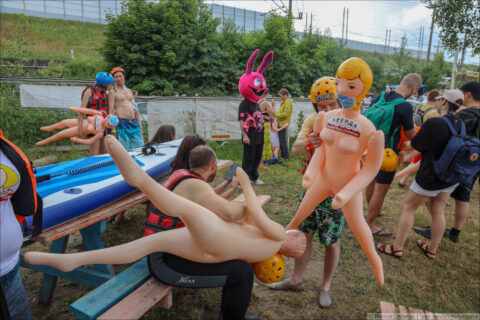In the summer of 2003, while Americans were perfecting the cannonball at local swimming pools and Europeans were lounging on Mediterranean beaches, Russians in the Leningrad region were pioneering an entirely different aquatic pursuit. They were hurling themselves down the churning Vuoksi River rapids while clutching inflatable sex dolls for dear life.
This was the birth of the Bubble Baba Challenge—perhaps history’s most improbable sporting event and a fascinating case study in how play, risk, and cultural identity converge in the theater of extreme sports.
The Beautiful Absurdity of Necessity
The origin story of the Bubble Baba Challenge follows that peculiarly Russian pattern of ingenious improvisation born from material constraints—what anthropologists might call “bricolage.” When St. Petersburg entrepreneur Dmitry Bulawinov conceived the race, he wasn’t making a deliberate statement about sexuality or athleticism. He was solving a practical problem: traditional river rafting equipment was prohibitively expensive for many Russians.
Sex dolls, on the other hand, cost roughly 500 rubles (about $10 at the time). They were lightweight, remarkably buoyant, and—crucially for a whitewater adventure—already waterproof. The fact that these flotation devices came in anatomically detailed human form wasn’t the point so much as a bonus—the punchline to a practical joke played on economic necessity.
What Bulawinov couldn’t have anticipated was how this makeshift solution would tap into something deeper in the Russian psyche—a cultural sweet spot where physical hardiness, absurdist humor, and theatrical spectacle intersect.
The Carnivalesque Spirit and Temporary Liberation
To understand the Bubble Baba Challenge fully, we might turn to Russian literary theorist Mikhail Bakhtin’s concept of the “carnivalesque”—those ritualized inversions of social order where conventional propriety is temporarily suspended. Medieval carnivals allowed peasants to mock nobility, sacred cows became fair game for ridicule, and the body’s “lower stratum” (everything below the waist) took center stage.
The Bubble Baba Challenge operated in precisely this tradition. Here were hundreds of otherwise conventional Russians—teachers, engineers, shop clerks—temporarily liberated from social constraints, careening down rapids while gripping inflatable paramours. Some wore elaborate costumes: superheroes, historical figures, traditional folk characters. The event became a contemporary carnival, complete with spectators lining the riverbanks like medieval townsfolk watching a procession of fools.
“What happens on the Vuoksi stays on the Vuoksi” might well have been the unofficial motto, except that it didn’t. Media coverage ensured the event’s notoriety expanded well beyond its geographical boundaries.
From Stunt to Sporting Ritual
What began as a publicity stunt quickly developed the hallmarks of a legitimate sporting event. By 2011, the race’s final year of official operation, participant numbers had swelled to over 800, with thousands more watching from shore. The Bubble Baba Challenge had developed its own lexicon, traditions, and hierarchy of achievements.
Veterans spoke of the unique skills required—how to position oneself with the doll to maximize stability, techniques for navigating particular rapids, strategies for maintaining one’s grip when hitting unexpected turbulence. Some competitors trained specifically for the event, taking practice runs with their silicone companions weeks before race day.
Winners were celebrated not merely for their speed but for their style, their costumes, and their ability to reach the finish line with dignity (and partner) intact. Like any sport worth its salt, the Bubble Baba Challenge had created its own merit system and community of practice.
 The Pleasure-Pain Paradox
The Pleasure-Pain Paradox
The race raises interesting questions about the psychology of what we might call “ludic masochism”—voluntary suffering undertaken in the name of fun. The Vuoksi River’s rapids are legitimately challenging; the water is cold; the threat of injury is real. Participants described the experience as physically punishing—yet they returned year after year, recruiting friends to join the madness.
This apparent contradiction aligns with what psychologists call the “benign masochism” phenomenon—our peculiar enjoyment of experiences that stimulate our threat-response systems while simultaneously reassuring us that no actual danger exists. It’s the same mechanism that explains why we enjoy spicy foods that cause pain, horror movies that terrify us, or roller coasters that simulate deadly falls.
The Bubble Baba Challenge offered this psychological cocktail in concentrated form: the genuine physical challenge of navigating whitewater combined with the comical safety blanket of clutching an inflatable lover. The absurdity of the situation created psychological distance from the discomfort, transforming potential fear into hilarity.
Sex, Death, and Rubber
The choice of flotation device wasn’t incidental to the race’s appeal—it was central to it. Sex dolls exist at a fascinating nexus of human preoccupations: they’re simulacra of humanity, uncanny valley objects that mimic life while remaining obviously artificial. Using them in a potentially dangerous river race creates a subversive symbolic matrix where sex, death, and artificial bodies converge.
Vladimir Propp, the Russian folklorist who categorized the structural elements of fairy tales, might have appreciated how the Bubble Baba Challenge functioned as a modern folk narrative, complete with challenges, helpers (the sex dolls serving as magical assistants), and transformations. Participants entered the river as ordinary people and emerged—if they finished at all—as heroes of an absurdist epic.
The race’s name itself reflects this playful linguistic subversion. In Russian slang, “baba” colloquially refers to a woman, while “bubble” approximates the Russian word for “inflatable.” The resulting double entendre is quintessentially carnivalesque in its union of the sacred (competition, athleticism) and profane (sexual innuendo).
The Politics of Play
The event’s cancellation in 2012 reveals much about the shifting political landscape in Putin’s Russia. Officials cited safety concerns—a reasonable pretext given the inherent risks. But the timing aligned perfectly with the government’s broader campaign to project an image of moral traditionalism and “cultural sovereignty.”
The Bubble Baba Challenge embodied exactly what the new conservative order found threatening: it was spontaneous rather than state-organized; it mocked conventional sexuality rather than reinforcing it; it showcased individual absurdity rather than collective dignity. An event featuring hundreds of half-naked Russians clutching sex dolls didn’t align with the national image being carefully constructed in Moscow.
This tension between grassroots cultural expression and top-down identity management remains a central dynamic in contemporary Russian society. That the race continues in unofficial form—participants organizing informally, without permits or publicity—speaks to the resilience of the carnivalesque spirit in the face of official prohibition.
The Universal in the Specific
While uniquely Russian in its expression, the Bubble Baba Challenge taps into universal human tendencies that manifest across cultures. The British have their cheese-rolling competitions at Cooper’s Hill, Finns carry their wives through obstacle courses, Spaniards run with bulls, and Americans plunge into polar bear swims.
These events share common elements: physical challenge, ritual performance, community bonding, and temporary suspension of everyday behavioral norms. They create what anthropologist Victor Turner called “communitas”—a heightened sense of social connection that emerges when people collectively step outside conventional social structures.
What makes the Bubble Baba Challenge distinctive is its ingenious repurposing of objects designed for private pleasure into instruments of public spectacle. In doing so, it exemplifies that uniquely human capacity to transform the pragmatic into the symbolic, the embarrassing into the celebrated, and the individual into the collective.
 An Enduring Legacy
An Enduring Legacy
Though officially banned, the Bubble Baba Challenge endures in Russia’s cultural memory and underground sporting scene. Former participants still organize unofficial races, and the event has inspired similar competitions on other Russian rivers—though none with quite the same scale or notoriety as the original.
More importantly, it captures something essential about the Russian approach to adversity: finding joy in harsh conditions, making do with available resources, and transforming hardship into celebration. As Russian writer Nikolai Gogol observed over a century ago, nowhere is the distance between tragedy and comedy shorter than in Russia.
In this sense, the image of hundreds of people navigating treacherous rapids while clutching inflatable dolls isn’t just bizarre spectacle—it’s a perfect metaphor for the human condition: we all face life’s turbulent currents, grasping whatever flotation devices we can find, sometimes looking ridiculous in the process, but occasionally discovering unexpected grace in our improvised solutions.
The Bubble Baba Challenge may be gone from official sporting calendars, but its legacy floats on—buoyant, absurd, and strangely profound.



